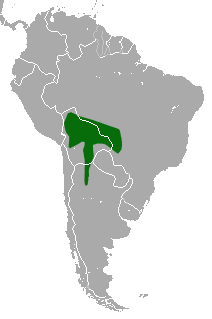White-bellied woolly mouse opossum: Difference between revisions
add description |
→Distribution and habitat: expand |
||
| Line 34: | Line 34: | ||
==Distribution and habitat== |
==Distribution and habitat== |
||
The opossum is found across northern [[Bolivia]], in the [[Brazil]]ian states of [[Mato Grosso]] and [[Mato Grosso do Sul]], and in northern [[Argentina]] as far south as [[Tucumán Province]].<ref name=iucn/> It has also recently been reported from [[Paraguay]].<ref name=Smith2016/> Across this region, it inhabits moist tropical forests, often near the boundary with drier habitats,<ref name=Caceres2007>{{cite journal | authors = Caceres, N.C., et al. | date = June 2007 | title = Mammals of the Bodoquena Mountains, southwestern Brazil: an ecological and conservation analysis | journal = Revista Brasileira de Zoologia | volume = 24 | issue = 2 | pages = 426-435 | doi = 10.1590/S0101-81752007000200021}}</ref> and has been found from near sea level to montane forests as high as {{convert|1000|m|abbr=on}} elevation.<ref name=Caceres2011>{{cite journal | authors = Caceres, N.C., et al. | date = May 2011 | title = Effects of altitude and vegetation on small-mammal distribution in the Urucum Mountains, western Brazil | journal = Journal of Tropical Ecology | volume = 27 | issue = 3 | pages = 279-287 | doi = 10.1017/S0266467410000854}}</ref> |
|||
It inhabits moist forests in eastern [[Bolivia]], the [[Brazil]]ian State of [[Mato Grosso]], and northwestern [[Argentina]]. |
|||
==Biology and behaviour== |
==Biology and behaviour== |
||
Revision as of 17:27, 31 December 2016
| White-bellied woolly mouse opossum | |
|---|---|
| Scientific classification | |
| Kingdom: | |
| Phylum: | |
| Class: | |
| Infraclass: | |
| Order: | |
| Family: | |
| Genus: | |
| Subgenus: | |
| Species: | M. constantiae
|
| Binomial name | |
| Marmosa constantiae (Thomas, 1904)
| |

| |
| White-bellied woolly mouse opossum range | |
| Synonyms | |
|
Micoureus constantiae (Thomas, 1904) | |
The white-bellied woolly mouse opossum (Marmosa constantiae) is a small pouchless marsupial of the family Didelphidae.[2] It was formerly assigned to the genus Micoureus, which was made a subgenus of Marmosa in 2009.[3]
Description
This is one of the larger mouse opossums, with a head=body length of 11 to 18 cm (4.3 to 7.1 in), a tail 15 to 23 cm (5.9 to 9.1 in) in length, and weighing from 35 to 144 g (1.2 to 5.1 oz). The fur is thick and woolly, and is grey over most of the body, fading to buffy-yellow on the head and underparts. There are clear, but narrow, rings of black fur around the eyes. The tail is furred only at the base, and is near black for most of its length, but changes suddenly to pale pink along the last third or so.[4]
The feet are broad, with stout claws and ridges on the underside of the toes that aid in climbing trees. Females do not have a pouch, but have fifteen teats arranged in a circle - more than in any of this species' closest relatives.[4]
Distribution and habitat
The opossum is found across northern Bolivia, in the Brazilian states of Mato Grosso and Mato Grosso do Sul, and in northern Argentina as far south as Tucumán Province.[1] It has also recently been reported from Paraguay.[4] Across this region, it inhabits moist tropical forests, often near the boundary with drier habitats,[5] and has been found from near sea level to montane forests as high as 1,000 m (3,300 ft) elevation.[6]
Biology and behaviour
It is arboreal and nocturnal. The main components of its diet are probably insects and fruit, but it may also eat small rodents, lizards, and bird eggs.
References
- ^ a b Template:IUCN2011.2 Database entry includes justification for why this species is of least concern
- ^ Gardner, A.L. (2005). "Order Didelphimorphia". In Wilson, D.E.; Reeder, D.M (eds.). Mammal Species of the World: A Taxonomic and Geographic Reference (3rd ed.). Johns Hopkins University Press. p. 12. ISBN 978-0-8018-8221-0. OCLC 62265494.
- ^ Voss, R. S.; Jansa, S. A. (2009). "Phylogenetic relationships and classification of didelphid marsupials, an extant radiation of New World metatherian mammals". Bulletin of the American Museum of Natural History. 322: 1–177. doi:10.1206/322.1. hdl:2246/5975.
- ^ a b c "Marmosa constantiae (Didelphimorphia: Didelphidae)". Mammalian Species. 48 (941): 123–129. December 2016. doi:10.1093/mspecies/sew012.
{{cite journal}}: Cite uses deprecated parameter|authors=(help) - ^ "Mammals of the Bodoquena Mountains, southwestern Brazil: an ecological and conservation analysis". Revista Brasileira de Zoologia. 24 (2): 426–435. June 2007. doi:10.1590/S0101-81752007000200021.
{{cite journal}}: Cite uses deprecated parameter|authors=(help) - ^ "Effects of altitude and vegetation on small-mammal distribution in the Urucum Mountains, western Brazil". Journal of Tropical Ecology. 27 (3): 279–287. May 2011. doi:10.1017/S0266467410000854.
{{cite journal}}: Cite uses deprecated parameter|authors=(help)

